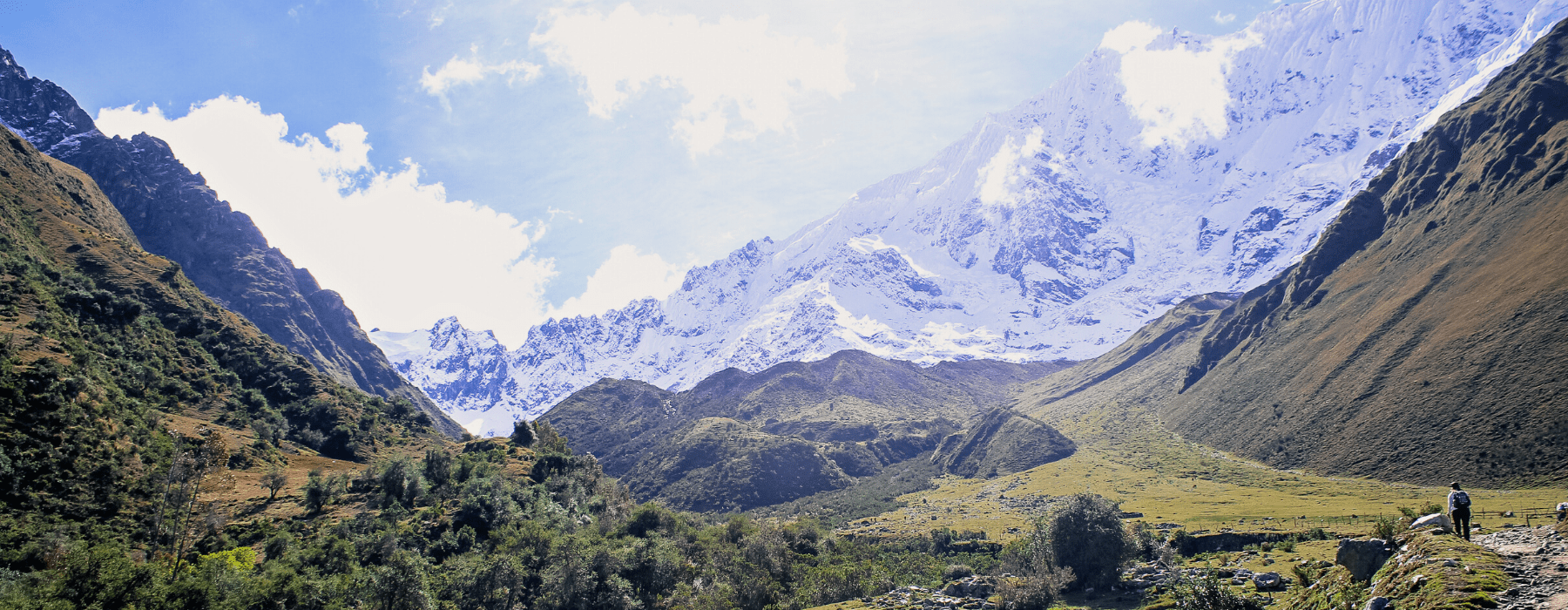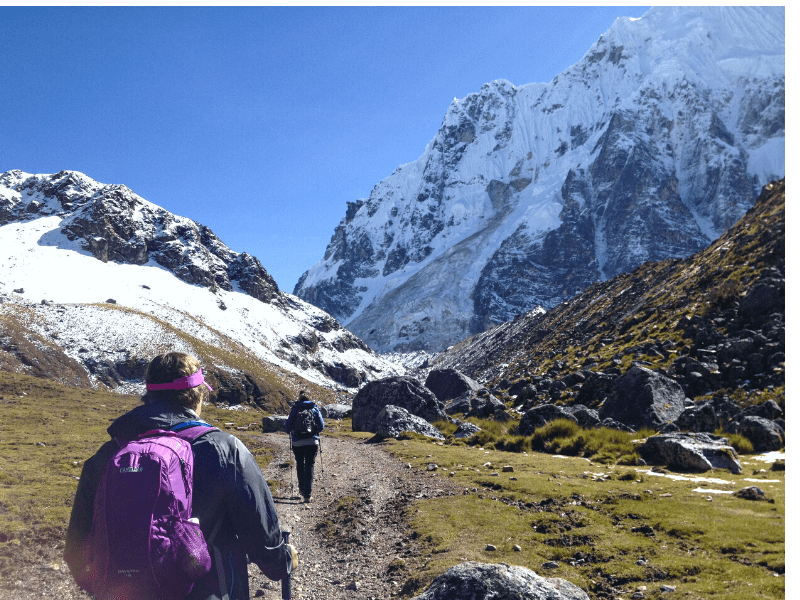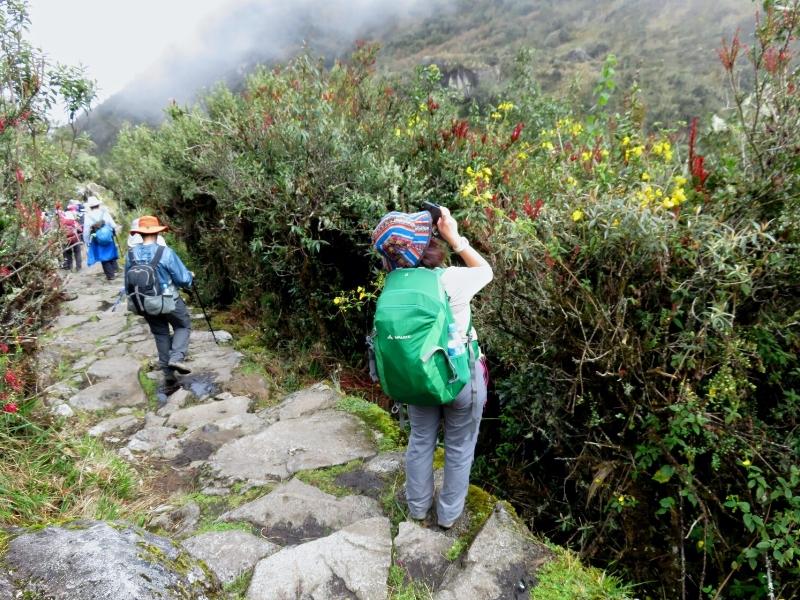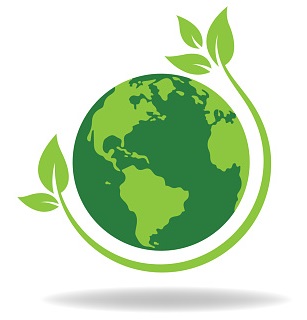
For an average traveller or tourist, Salkantay Trek is considered a challenging but certainly not impossible hike. Due to the physical demands, anyone who wishes to hike Salkantay Trek should at least be moderately fit. Plus, all trekkers should spend at least 2 days in Cusco before the trek, to get acclimatized. Being extremely fit does not grant any immunity from altitude sickness.
The entire hike is approximately 72 kilometers (approximately 45 miles), and this hiking takes place during 4 days. The remaining 1 day of the trek is spent at Machu Picchu. In general, Salkantay is not considered to be harder than the Inca Trail.
The Salkantay Pass, at 14,760 feets above sea level, is the most difficult section in the trail. Expect wind and cold temperatures. Some hikers might experience symptoms of altitude sickness. Symptoms will disappear as soon as you start your descent. Oxygen will be provided if needed. The Salkantay Pass, at approximately 4,650 meters above sea level is the most difficult section in the trail. These challenges are a result of several factors: the challenge of uphill climbing, bitter cold winds, low temperatures in general, and the fact that you are trekking at a low-oxygen altitude.
The Salkantay trek is a hiking route that takes the visitor to the Inca City of Machu Picchu. The total Salkantay Trek distance is approximately 74 Kilometers (45.98 miles), which are traveled in 5 days, 12 kilometers distance on average per day.
The maximum elevation is 4600 meters or 15,091 feet. This height corresponds to the pass of the second day, since then we will descend to 1800 meters or 5905 feet. The elevation of Machu Pichcu is 2400 meters or 7874 feet.
To avoid altitude sickness we recommend arriving at the city of Cusco 2 or 3 days before, and thus acclimatize your body.Try to avoid alcohol before and during your trek, and make sure you eat lightly and drink plenty of water. Make sure to stay hydrated during the trek, don’t force yourself to walk faster than your body wants to, and take frequent breaks. Drinking coca leaf tea helps a lot, and you may wish to speak with your doctor about Diamox pills.
We recommended booking at less 4 or 5 months in advance. The government has strictly limited the number of people permitted on Machu Picchu (permits are issued to about 2500 per day). We therefore recommend that you try to make your Salkantay Trek to Machu Picchu reservation as far in or as soon as you know the dates of your international flights.
Since January 2019, the visit tickets to Machu Picchu have been divided into several schedules, obviously the most requested is that of 6:00 am, because there are not many visitors, and also in the dry season you have the opportunity to appreciate the sunrise.
March, April, May to October: Salkantay trek departure dates during these months have sold out as soon as the trek permits go on sale at the beginning of January so we would recommend making a booking in advance.
The amount you walk each day varies. An average day is 6-7 hours. Have a look at the itinerary for a day-to-day account.
Weather conditions during the rainy season makes the Salkantay Trek into a risky decision. Therefore we don’t arrange this tour from January until mid March.
The dry season is the best time for Salkantay Trek to Machu Picchu. In Cuzco, the dry season lasts from April to November, and the wet season is from December to March. From June to September are the most popular months to do the trek, due to summer vacations in Europe and the US. It is generally thought that May and October offer the best weather conditions.
Weather is very varied on the Salkantay Trek, due to the fact that it winds its way through wildly different terrain at different altitudes.
The only place where weather is a serious concern is the Salkantay Pass, and the nearby areas. Temperatures here, and at the nearby Soraypampa campsite, can fall below freezing. The other camps are much warmer, due to their proximity to the cloud forest.
In all the tours that are made to the citadel of Machu Picchu it is necessary to make a reservation deposit, which will serve for the immediate purchase of your entrance tickets to the sanctuary of Machu Picchu, also for the purchase of your train tickets. Once the reservation is made, our team will confirm your reservation by mail.
The balance of the tour will be paid upon arrival in Cusco, for that you must come to our office, where everything about the walk will be explained in detail, and if you have any other questions you will also be cleared.
To make the payment of the preference balance in cash, if you do it by means of a visa or mastercad card you have a charge of 5.5%.
First, we will send you an email to confirm your payment. Two weeks before your tour date, we will contact you by email to request the final payment. We will also ask you where you will be staying in Cusco, to be able to pick you up on the day of your hike.
The briefing is important because you will have details of the hike to Salkantay Trek, you will be given a duffel bag for your luggage, you also pay the remaining balance and we will give you a map with the route developed.
The first day of trekking in the Salkantay trek, the maximum temperature is 15 °C or 59 °F, and the minimum in the winter season (May to August) is -6 °C or 21 °F.
On the second day only during the ascent to the Salkantay pass there are average temperatures of 2 C ° to 0 C °. Since then we enter the cloud forest where the weather is more pleasant. Thus, on days 3th to 5th, temperatures are recorded during the day with full sun of 25 °C or 77 °F, and at night in hot water it has a moderate temperature of 10 °C or 50 °F.
Walking sticks on the Salkantay Trek route is more recommended for those who have a little weak knees and ankles, or are not used to long walks. The level of difficulty of Salkantay Trek is moderate, since on this route you will not go up or down stairs like on the Inca Trail to Machu Picchu. In short, you should have the habit of walking with trekking poles. Otherwise they will be very uncomfortable. Another important aspect to keep in mind is that on day 2 we will have more than 4 hours of descent, and they could help you in the balance and balance of your body, since the terrain is very slippery if there is rain.
You can definitely rent sleeping bags in our office, for the Salkantay Trek route. Our sleeping bags are designed to withstand extreme temperatures. The cost is $ 20 usd for all the trip.
The first three days we will sleep in huts, which inside has the trekking tent with a mat, with this structure we protect you a little more from the cold, the capacity is for two people.
The hotel for Salkantay Trek hikers in Aguas calientes town is Machupicchu Lodging all the romos has private bathroom and wifi.In case you want to rest in a hotel with a better category of 2 or 3 stars, just send us an email prior to your reservation, and tell you the aditional cost.
One of our strengths is the food we provide on the Salkantay Trek, which is why our company has been working with high mountain cooks for more than 10 years. They are going to bring you the best gastronomy of Cusco and Peru. At breakfast there will be scrambled eggs, omelets, pancakes, coffee, milk, butter, etc. Lunches are very nutritious (quinoa chaufa, steak, chicken stew, sauteed tenderloin, stuffed avocado, etc). And dinner is designed according to the type of weather, for example the first night you will have a refreshing soup for the cold and altitude sickness. The last day we will have dinner at a restaurant in Aguas Calientes. If you have any food restrictions, do not worry, since our chefs are prepared for all types of food restrictions, such as vegetarians, vegans, or allergies to gluten and others. All foods are prepared with fresh and organic ingredients, produced by the farmers of the Sacred Valley of the Incas.
If water is included in the Salkantay Trek route, you should only buy water for the first day. Then our cooks will fill you with clean and safe water to drink, we drink the water from the cleanest sources and then it is boiled and filtered. If possible, please avoid taking water from springs, rivers or lagoons, since we do not certify the quality of the water, even if you carry the purification tablets, perhaps those bodies of water are contaminated with heavy minerals, which come from the mountains, which can cause poisoning to your body. If you are drinking a lot of water, do not worry, since there will always be ladies who sell bottles of water throughout the villages we pass. If possible avoid carrying many plastic bottles, prefer to carry a canteen or camel back, so you will be contributing to the care and responsible use of environmental resources.
Yes. This is very important!!! .We recommend that you have to bring 300 to 400 Peruvian soles. It is possible that you may not need any of this money, but just in case of an emergency you should make sure to have plenty of cash. If you are struggling on the route, you can use the money to purchase alternative forms of transportation such as: car, horse, and train. If you are participating in the 5-day trek, there are a couple of extra activities along the way including hot springs.
Yes on the second and third night you will have access to electricity and Wi-Fi at an additional cost of 10 Peruvian Soles. And in your Aguas Calientes Hotel as well.
If you choose to go on a private tour, the tour will be tailored to you. The size of the group depends on you and only you. You can decide exactly who will be on the trek with you. This is perfect for couples, families, or groups of friends. You will have your own personal chef and guide, which means the trek is more personalized and able to satisfy your personal needs.
Yes. You will have the chance to take showers and use the bathroom.
Since we use facilities provided to us by local families, there is a fee of 10 Peruvian soles to use the hot shower at each campsite.
There are bathrooms at each campsite, and at the sites where you will stop for lunch.
In the Salkantay Trek it is only necessary to rent a horse for the ascent section to the pass, after the whole route is of descent.You can rent a horse from any of the community members who are going to offer you this service, the cost is according to each owner of the horse, remember that Andean Path Trek is not owner of the animals, and if an incident occurs in the route of the climb it will not be not our fault, also keep in mind that these horsemens do not speak English, and you will be most of the tour separated of the group. And you will meet with your group again at lunchtime.
In the 5-day tour, the visit to the Llaqtapata viewpoint is made, from where you can enjoy an incredible view of the Sacred Sanctuary of Machu Picchu. On the other hand, in the 4-day tour you will be transferred after lunch in Lucmabamba, in a local transport to the town of Hidroelectrica, from where you will walk for 3 hours to the town of Aguas Calientes.
Huayna Picchu – The hike to the summit is approximately 45 minutes, along narrow and steep Inca stairs. Once at the top, you get to see the Citadel of Machu Picchu and its surrounding hills and valleys. This is the famous peak in the background of every iconic Machu Picchu photo. Summiting Huayna Picchu is always a top item on most Machu Picchu visitor’s lists which means that you usually need reserve this mountain 6 months in advance. Only a certain amount of people are allowed to hike this mountain each day (currently 400). Along this trek you’ll see breathtaking views of the Machu Picchu ruins. The limited number of tickets is a restriction set forth by the ministry of culture in Cusco, not by Andean Path Trek. This is completely out of our hands unfortunately.Tickets for this mountain are non-transferable.
Machu Picchu Mountain – The hike to this summit is approximately 1.5 hrs. Once at the top, you get a much higher vantage point so you have an amazing view of the Citadel of Machu Picchu and its surroundings. This hike is a great alternative to Huayna Picchu. It is ideal for those who don’t want the hassle of fighting for a ticket, or who were unable to get one. Technically, spaces for Machu Picchu Mountain are also limited to 400 per day, as well it’s use to sold We simply need to reserve a space when we buy your entrance tickets. This trek is great because it will also take you high up like Huayna Picchu, offering great views. This trek has an easier incline (also making it accessible for those who fear the heights of Huayna Picchu), but the path is much longer making it equally as challenging in it’s own way.
The Inca Trail hike has an unique beauty for its archaeological remains, and ecological floors, orchids and birds. On the Salkantay route, the main attraction is the Humantay lagoon and the beautiful snow, there are no archaeological remains in the salkantay trek.
The Inca Trail has a higher cost because this route can only be operated with the help of porters, who are paid a salary according to the regulation of the Ministry of Labor. While in the Salkantay Trek it is done with the help of horses for the transport of trekking equipment, which makes it less expensive.
And we want to deny what in many blogs they are saying that the Inca Trail is very crowded, the truth is not so, in the Inca Trail, each group goes at its own pace and times, so it is rarely that you will meet the Groups except for the overnight camp. Lately on the Salkantay route, human activity has changed the true spirit of adventure, as many companies use modern lodge-like buildings, with the comfort of the case. And as additional information we want to give you that the Salkantay Trek route is also very crowded, even more than the Inca trail to Machu Picchu.
On the Inca trail you don’t see many villages, the whole circuit is far from civilization, while in the Salkantay Trek there are many towns and villages.
The level of difficulty is a very important aspect, since the Inca trail is the one that has the highest amount of ascents and declines with stairs, while the Salkantay Trek is only difficult the second day to reach the pass.
In what corresponds to the provision of hygienic services both have modern facilities, for the comfort of the client. In all camps and lunch points.
If you hike the Inca trail you will have the opportunity to see the sunrise of Machu Picchu from the sun gate. While in the Salkantay Trek you can only enjoy the sunrise into the citadel of Machu Picchu, which is also very beautiful.
Children under 14 years old are not allowed to do the trek, and children who are over 14 years old should be in good physical shape and used to hiking long distances.
No. Unfortunately our company has a no refund policy. All $200.00 deposits are non-refundable and non-transferable. We understand that unexpected things happen that are out of your control, but we can’t make exceptions. To get more information, please check our terms and conditions.

Salkantay Trek is the second best hiking option to Machu Picchu, offering a totally full of natural scenes , passing the majestic Salkantay snow mountain.

Salkantay Trek to Machu Picchu 5 days, a great hike from Cusco to the Andean mountains. The salkantay trek is the best alternative trek to machu picchu.

Ancascocha Trek & Classic Inca Trail to Machu Picchu will take you through beautiful landscapes and snowy mountains surrounded by colorful lakes and waterfalls. You will discover ancient inca ruins, local flora and fauna of Machu Picchu.
 LOCALLY INSPIRED, DELICIOUS FLAVOURS
LOCALLY INSPIRED, DELICIOUS FLAVOURS
 OUR PASSIONATE TOUR GUIDES
OUR PASSIONATE TOUR GUIDES
 YOUR SAFETY OUR PRIORITY
YOUR SAFETY OUR PRIORITY
 ENVIRONMENTAL SENSITIVITY
ENVIRONMENTAL SENSITIVITY
 CAMPING EQUIPMENT
CAMPING EQUIPMENT
 SMALL GROUPS & BIG ADVENTURES
SMALL GROUPS & BIG ADVENTURES